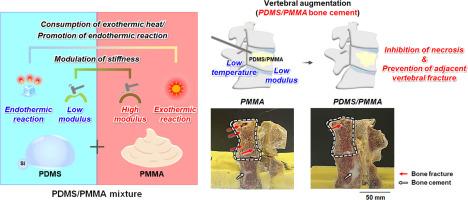低模量pmma骨水泥用于椎体成形术后相邻椎体骨折复位。
IF 9.6
1区 医学
Q1 ENGINEERING, BIOMEDICAL
引用次数: 0
摘要
采用聚甲基丙烯酸甲酯(PMMA)骨水泥进行椎体增强是一种广泛应用于椎体压缩性骨折的治疗技术。在本研究中,开发了聚二甲基硅氧烷(PDMS)增强PMMA骨水泥(PDMS/PMMA)来解决传统PMMA骨水泥在椎体成形术中的显著局限性:过度放热导致正常骨组织坏死和高刚度导致相邻椎体骨折。将PDMS掺入PMMA骨水泥中,可以消耗聚合过程中产生的热量,从而防止周围组织坏死,加快PDMS的固化过程,显示出PMMA和PDMS之间的协同效应。PDMS均匀分散在PMMA骨水泥中不会显著改变骨水泥的x线造影剂。用骨质疏松的猪椎骨进行的离体实验表明,与单独使用PMMA治疗的椎骨相比,注射低模量PDMS/PMMA(10/90)的椎骨明显延迟相邻骨折的发生。本研究提出低模量pmma基骨水泥可作为椎体成形术的先进治疗材料。意义声明:PMMA骨水泥椎体成形术由于其高刚度和放热固化,可损伤周围骨组织,常导致继发性相邻椎体骨折。在这项研究中,我们开发了一种含有pdms的PMMA骨水泥,它可以显著降低固化温度和刚度,同时保持生物相容性和放射透明度。PDMS和PMMA之间的协同作用有助于减少热坏死,降低相邻椎体骨折的风险。用骨质疏松的猪椎骨进行的体外试验表明,与传统的PMMA骨水泥相比,含pdms的低模量PMMA骨水泥可显著延迟相邻骨折。这项工作提出了一种克服椎体成形术长期并发症的策略,并可能有助于骨质疏松性椎体压缩性骨折更安全、更有效的治疗选择。本文章由计算机程序翻译,如有差异,请以英文原文为准。

Low modulus PMMA-based bone cement for the reduction of adjacent vertebral fractures after vertebroplasty
Vertebral augmentation employing polymethylmethacrylate (PMMA) bone cement is a widely used therapeutic technique for treating vertebral compression fractures. In this study, polydimethylsiloxane (PDMS)-enhanced PMMA bone cement (PDMS/PMMA) was developed to address the significant limitations associated with traditional PMMA bone cements in vertebroplasty: excessive exothermicity causing necrosis of normal bone tissues and high stiffness leading to fractures in adjacent vertebrae. The incorporation of PDMS into the PMMA bone cement results in consumption of the heat generated during polymerization, which prevents necrosis of surrounding tissue and speeds up the curing process of PDMS, showcasing the synergistic effects between PMMA and PDMS. The PDMS uniformly dispersed in the PMMA bone cement does not significantly alter the radiographic contrast of the cement. The ex vivo experiments conducted using osteoporotic porcine vertebrae demonstrated that vertebrae injected with low modulus PDMS/PMMA(10/90) exhibited a significant delay in adjacent bone fracture compared to those treated with PMMA alone. This study proposes that low modulus PMMA-based bone cement may serve as an advanced therapeutic material for vertebroplasty.
Statement of significance
Vertebroplasty using PMMA bone cement often leads to secondary adjacent vertebral fractures due to its high stiffness and exothermic curing, which can damage surrounding bone tissue. In this study, we developed a PDMS-containing PMMA bone cement that significantly reduces curing temperature and stiffness while maintaining biocompatibility and radiopacity. The synergistic interaction between PDMS and PMMA helps minimize thermal necrosis and reduces the risk of adjacent vertebral fractures. Ex vivo tests using osteoporotic porcine vertebrae demonstrated that the low-modulus PDMS-containing PMMA bone cement significantly delayed adjacent fractures compared to conventional PMMA bone cement. This work presents a strategy to overcome long-standing complications of vertebroplasty and may contribute to safer and more effective treatment options for osteoporotic vertebral compression fractures.
求助全文
通过发布文献求助,成功后即可免费获取论文全文。
去求助
来源期刊

Acta Biomaterialia
工程技术-材料科学:生物材料
CiteScore
16.80
自引率
3.10%
发文量
776
审稿时长
30 days
期刊介绍:
Acta Biomaterialia is a monthly peer-reviewed scientific journal published by Elsevier. The journal was established in January 2005. The editor-in-chief is W.R. Wagner (University of Pittsburgh). The journal covers research in biomaterials science, including the interrelationship of biomaterial structure and function from macroscale to nanoscale. Topical coverage includes biomedical and biocompatible materials.
 求助内容:
求助内容: 应助结果提醒方式:
应助结果提醒方式:


